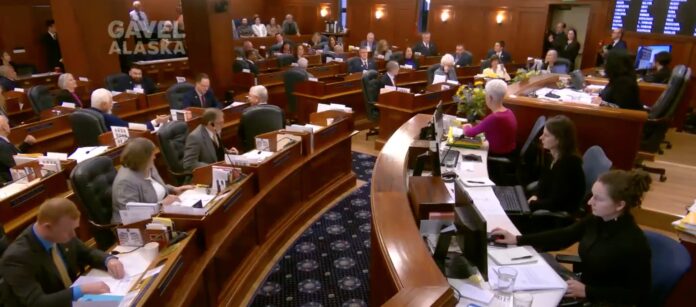Update: This has now been delayed and will not be on the floor on Friday.
The Alaska House will take up Senate Bill 140 on the Friday floor calendar. What started out with Sen. Lyman Hoffman proposing spending for rural school internet has become a bill that brings up the base funding for education and has other contentious components.
The current base student allocation — the base amount of funding for schools by the State of Alaska — would go up by $300 under the current proposal. But once this bill hits the House floor, Democrats plan to try for $1,000 or more in additional spending, while some Republicans will back a $600 amount that is being crafted in legislative offices.
The House gavels in at 11 am and the proceedings can be watched online at Gavel Alaska.
Unions have swarmed the Capitol this week and are pressuring lawmakers to add more money to districts. How districts spend that money is up to them.
The argument from the education industry is that Alaska school funding is inadequate. Some, like Gov. Mike Dunleavy, want to tie additional spending to accountability. That’s why he worked to get the Alaska Reads Act passed — it was focused on the students, not administrators.
Others, like the National Education Association and other education unions, want the money without strings.
The Alaska Policy Forum says that unfocused education spending does not mean better results. Alaska spends per pupil is $20,191.
Alaska’s current expenditures were the highest nationwide in 2015, according to the NEA. But Alaska ranks 49th in fourth-grade reading, according to the National Assessment of Educational Progress test.
Between 2008 and 2019, Alaska’s education administrators grew their ranks nearly 18%, while the number of teachers fell 5.8%, according to the Alaska Policy Forum.
Alaska has 54 school districts, all with administration costs. Some are as as small as Pelican School District, with 16 students and two teachers. Anchorage, the largest, has 43,000 students and 2,053 classroom teachers, a student-teacher ratio of 17:1. Across the state, Alaska’s K-12 enrollment in public schools has continued to decline. Anchorage schools are losing 2% enrollment every year, but the Anchorage School Board has not had the courage to start closing schools.

Governor Dunleavy fixed our education problem by dropping standards, my cable bill just went up. I need that PFD!
So where is the proof that the schools earned that increase in BSA? Even the $300? I have not seen one iota of proof of performance. Sorry schools, you need to prove yourself before you get an increase in funds. Yeah got it, my opinion.